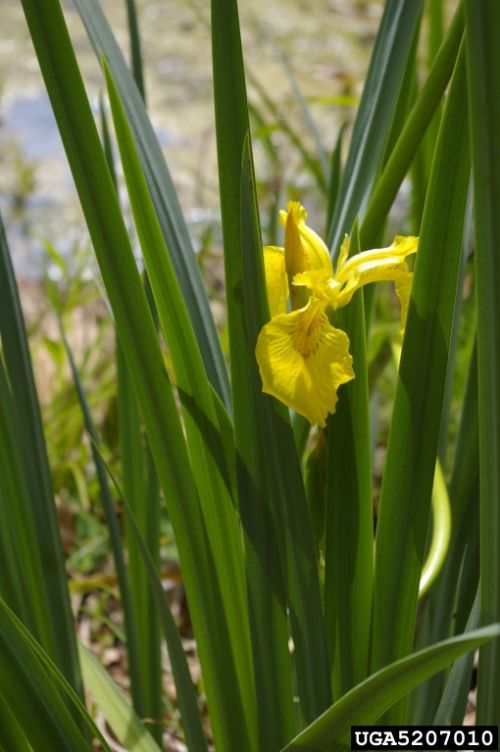
Priority: Eradicate
General: A yellow iris that is often grown in gardens. This particular one, however, likes wet environments and has been used for ponds.
Height: Grows up to 1.5m.
Flowers: It has one or more showy yellow flowers per stem. They are large with three petals facing up and three larger petals dropping down.
Leaves/Stems: The leaves are very long and pointed (50-90cm), between 1-3cm wide and grow primarily from the bottom of the plant. Stems are smooth, usually single but can be branched.
Root: Roots are thick, fleshy, and horizontal, 1-4 cm thick and form thick mats. These roots can still survive if fully dried out.
Yellow iris, Water Flag, Yellow Flag, Pale yellow iris
Siberian Iris (Iris sibirica).
Differences: Yellow flag iris has bright yellow flowers with 3 petals pointing upward and 3 downward.
Where did it come from? Introduced as a garden ornamental to North America in the 1800’s.
Where does it grow here? Grows in a variety of environments but prefers wet areas like ditches, marshes, wetlands, lakeshores and ponds. It can survive submerged in water. It prefers full sun to partial shade environments. There are 2 lakes in our region that have had infestations.
Reproduction: Both by seed and roots. Seeds are developed in banana-shaped pods that float. Each plant can produce several hundred seeds.
When does it grow, flower & seed? Sprouts April-May. Flowers June-August. Seeds September-October. Flowers after 2-3 years.
Spreads By: Seed pods can float in water for 2-3 months and establish downstream or new shoreline locations. Root fragments can also break off and establish in new locations. Shoreline disturbance can cause movement of this plant.
Plant Type: Perennial aquatic plant.
- Large, dense infestations of Yellow Flag Iris can out compete native vegetation and alter watercourses. This plant can take over important places to wildlife like wetlands.
- It is poisonous to animals and humans if accidently ingested. The sap can cause skin irritation.
- Plants can clog irrigation systems and compact soil.
- Review your property regularly for this species. Do not buy this plant for gardens.
- Treatment Remove small patches before it flowers & sets seed. Manual removal by digging can be effective. The entire plant must be removed including as much of the root mat as possible.
- Cover bare patches or disturbed soil by planting or seeding with non-invasives. Planting of native species to restore areas should be considered.
- Check areas where you have removed invasives for any new plants that year and in future growing seasons.
- Dispose of invasive plants responsibly. Bag them for disposal at the local landfill. Composting and burning are not recommended.
- Contact LRISS for specific treatment recommendations.
E-Flora BC: Electronic Atlas of the Flora of British Columbia
Southern Interior Weed Management Committee. 2016. Invasive Plants of the Southern Interior BC. 86pgs.
Okanagan Invasive Species Online website
